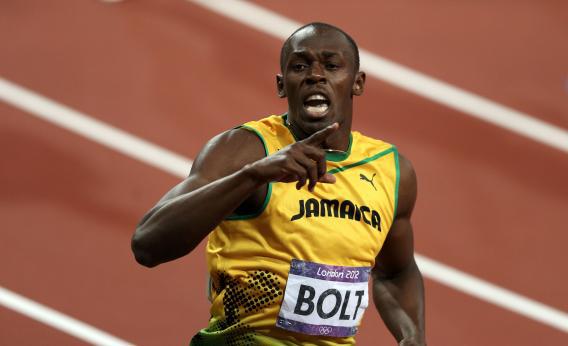After winning the 200-meter dash on Thursday, Usain Bolt, the world’s fastest and most-modest man, regaled the press with tales of his own excellence. “I’ve done something that has never been done before and because of that I am the greatest. The greatest ever,” he said.
He might be right. A recent Economist article reviewed some academic research suggesting that Bolt is coming very, very close to the maximum speed at which humans can run.
Mark Denny, a professor at Stanford who studies the biomechanics of mussels, crabs, and kelp, published a paper in 2008 titled “Limits to running speed in dogs, horses and humans.” Denny, who analyzed trends in on-track achievement and population data to predict the maximum rate at which humans can run, concluded that the fastest achievable 100 meter speed is probably 9.48 seconds—0.10 seconds faster than Bolt’s current world record. Writes Denny: “Bolt’s records are not out of line with the logistic fit to the historical data…. there is nothing in Bolt’s records to suggest that the predictions made here are inaccurate or that human speeds in the 100-meter and 200-meter races are limitless.”
Of course, Denny published his paper before Bolt smashed his own world record in 2009, running the 100-meter dash in 9.58 seconds—a full 1 percent faster than his previous record time of 9.69 seconds. This drastic improvement doesn’t necessarily refute Denny’s points, but it does serve to underscore the limitations of peak speed prediction. Denny himself acknowledges these limitations, noting in his paper that it is much easier to predict peak speeds for dogs and horses than it is for men, and that, in any event, “all such extrapolations must be used cautiously.”
How else might Bolt continue to improve his speeds? Mathematician John Barrow thinks that if Bolt can improve his reaction time off the starting blocks, he could lower his record to 9.55 seconds; if he was also running at altitude and with a tailwind, he might get down to 9.47 seconds. Peter Weyand, who teaches physiology at Southern Methodist University, thinks runners could theoretically go as much as 33 percent faster, if only there was some way to combine the power of one-legged hopping with the speed of sprinting. In his paper “The biological limits to running speed are imposed from the ground up,” Weyand and his co-authors explain that hopping generates more force than sprinting, because your foot is in contact with the ground for a longer period of time, thus letting your muscle fibers work to their top potential. How might sprinters harness this power? Weyand suggests two ways: by evolving faster-twitch muscle fibers, or by somehow lengthening their legs.
Here’s where this is leading: Someone like Oscar Pistorius, with prosthetics that can theoretically be customized to correct the deficiencies inherent in our puny human legs, is probably the best candidate to break the 100-meter speed limit. (Weyand has published on that topic, too.) Usain Bolt might be the fastest man on earth. But he can’t hope to measure up to an equally gifted man-machine.
